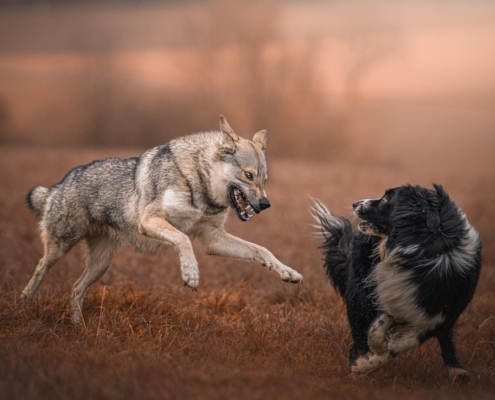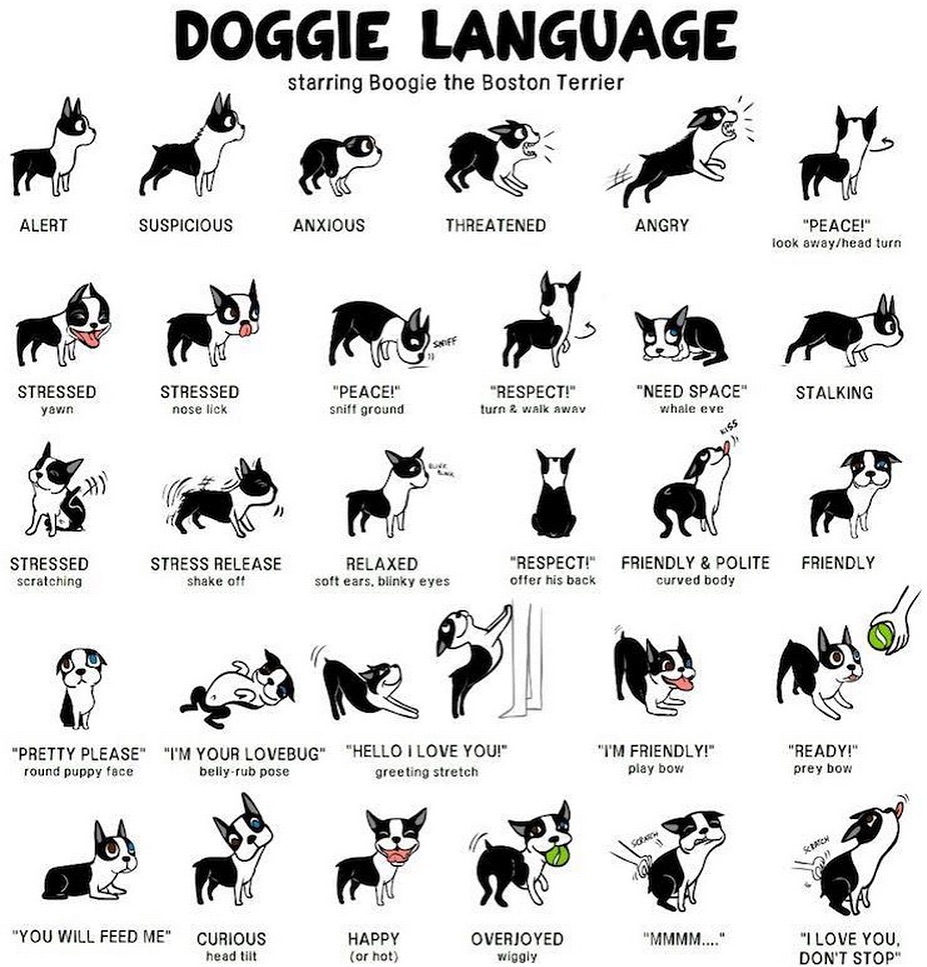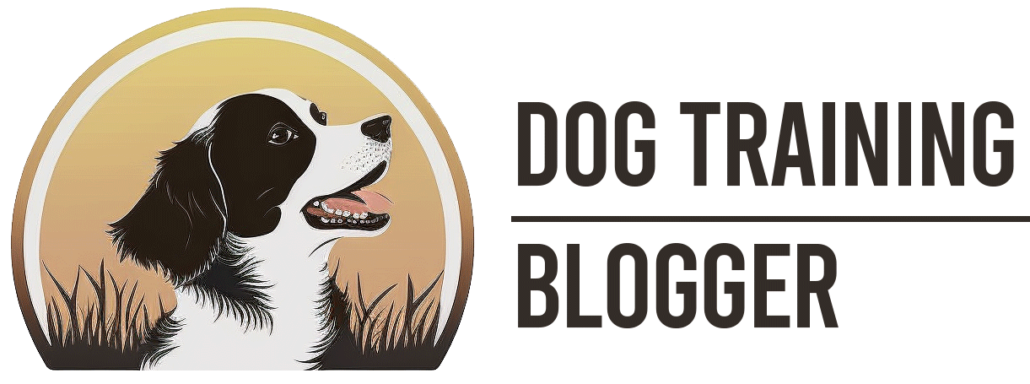Understanding Dog Body Language: A Key to Effective Training
One of the most important aspects of successful dog training is understanding your dogs body language.
Dogs don’t talk like us and rely heavily on body language to communicate their feelings, needs, and intentions. By learning to read and interpret these signals, you can improve your training techniques, prevent misunderstandings, and strengthen the bond between you both.
In this article, we dig into the basics of dog body language and use as many examples as possible to help you.
| Key Takeaways |
|---|
| Dogs primarily communicate through body language, which can vary depending on breed, personality, and past experiences. |
| Dog communication includes visual signals, vocalizations, and scent-based communications. |
| Misconceptions about dog body language can lead to misunderstandings between dogs and their owners. |
| Facial expressions, posture, and body movement can provide valuable insights into a dog’s emotional state and intentions. |
| Recognizing stress signals in dogs is essential for training, and positive reinforcement training requires an understanding of body language. |
| Paying attention to a dog’s body language can enhance communication, prevent misunderstandings, and strengthen the bond between dog and owner. |
| To improve reading a dog’s body language, one can observe them in different situations, learn from other dogs, and trust their instincts. |
The Basics of Dog Body Language
Dogs rely on body language as their primary form of communication since they don’t have the ability to speak like humans. There are some general rules for interpreting body language, such as:
- A relaxed body posture, with a wagging tail and open mouth, usually indicates a happy and content dog.
- Stiff body posture and direct eye contact can signal that a dog is feeling threatened or aggressive.
- A dog with its tail tucked between its legs and ears flattened is likely feeling frightened or submissive.
Remember, each dog is unique, and their body language may vary depending on their breed, personality, and past experiences.
It is essential to pay close attention to your dog’s individual cues and learn to interpret them in context.
How Dogs Communicate with Each Other
Dogs have a complex system of communication that allows them to convey information about their social status, intentions, and emotions. This communication system includes:
Visual signals
Dogs use various visual cues to express their emotions, intentions, and needs.
Some common visual signals include facial expressions, body posture, tail and ear positions, and movement.
Vocalizations
In addition to visual signals, dogs also communicate through vocalizations like barking, growling, whining, and howling.
Each vocalization can convey a different message depending on the context (very important) and your dog’s individual personality.
Scent and pheromones
Dogs have an incredible sense of smell and use it to communicate with other dogs and their environment.
While it may be challenging to detect these scent-based communications as a human, it’s essential to be aware that your dog is continually gathering information through their nose.

Common Misconceptions with Dog Body Language
There are several common misconceptions about dog body language that can lead to misunderstandings between dogs and their owners.
As always, context is everything. If you have two dogs that know each other well, play poses can be used during play fighting and it means nothing more than “play”, however if the dog feels threatened or it feels it needs to protect its owner, these could mean a whole different thing. So everything needs to be understood in context.
These are (but not limited to!):
Tail wagging always means happiness
While a wagging tail can be a sign of a happy dog, it can also indicate other emotions such as excitement, nervousness, or even aggression in some dogs.
It is essential to consider the dog’s overall body language and the context in which the tail wagging is occurring.
A dog showing its belly is always submissive
When a dog exposes its belly, it can be a sign of submission, but it can also be a way for the dog to cool down or simply a playful gesture.
Again, consider the context and the dog’s overall body language to accurately interpret this signal.
Growling always means aggression
While growling can indicate aggression, it can also be a warning sign that the dog is uncomfortable or fearful.
It is crucial not to punish a dog for growling, as it is their way of communicating their discomfort and suppressing this behavior can lead to more significant issues down the line.
Reading Your Dog’s Facial Expressions
A dog’s facial expressions can provide valuable insights into their emotional state and intentions.
Some things to focus on include:
Eyes
The direction and intensity of a dog’s gaze can convey a lot of information. A direct stare can be a sign of aggression or assertiveness, while an averted gaze can indicate submission or fear.
Mouth
And teeth exposed can signal aggression or fear. A dog that is panting or licking its lips may also be experiencing stress or anxiety.
Ears
The position of a dog’s ears can indicate their emotional state. Erect, forward-facing ears typically signal alertness or curiosity, while flattened ears can indicate fear or submission.

Interpreting Dog Posture and Body Movement
A dog’s posture and body movement can provide vital information about their emotional state and intentions.
Some of the most common postures include:
Relaxed posture
A dog with a loose, relaxed body posture and a wagging tail is likely content and comfortable.
Alert posture
An alert dog will have a more rigid body, with ears pricked forward and tail held high. This posture indicates that the dog is paying close attention to something in its environment.
Submissive posture
A submissive dog may lower its body to the ground, tuck its tail between its legs, and avert its gaze. This posture signals that the dog is not a threat and is trying to avoid conflict.
Dominant posture
A dominant dog may stand tall with its chest puffed out, ears forward, and tail held high and stiff. This posture signals confidence and assertiveness.
Fearful or aggressive posture
A dog that is fearful or aggressive may have a stiff, tense body, with its hackles raised, tail tucked, and ears flattened. It may also growl, snarl, or bark.
Recognizing Stress Signals in Your Dog
It’s essential to recognize when your dog is feeling stressed during training sessions or in other situations. Some signs of stress in dogs include:
Subtle signs
Yawning, licking lips, panting, or averting their gaze can be subtle signs of stress in dogs.
Overt signs
More obvious signs of stress may include whining, barking, growling, trembling, or attempting to escape the situation.
How to address stress during training
If you notice your dog showing signs of stress during training, it’s essential to pause and assess the situation. You may need to adjust your training approach, give your dog a break, or address any environmental factors that may be causing stress.
The Role of Tail and Ear Positions in Dog Communication
Tail and ear positions can convey a lot of information about a dog’s emotional state:
Tail positions
A high, stiff tail often indicates arousal or assertiveness, while a low, tucked tail can signal fear or submission. A wagging tail can indicate happiness, excitement, or nervousness, depending on the overall body language and context.
Ear positions
Ears held forward and erect signal alertness or curiosity, while ears flattened against the head can indicate fear or submission. Sideways-pointing ears may signal that the dog is relaxed or unsure of the situation.

Positive Reinforcement Training and Body Language
Understanding your dog’s body language is essential in positive reinforcement training, as it allows you to:
- Recognize when your dog is engaged and ready to learn, and when they may need a break or a different approach.
- Identify and respond to any signs of stress, ensuring a more positive and successful training experience for both you and your dog.
Importance of Body Language in Training
Paying attention to your dog’s body language during training is crucial for several reasons:
Enhancing communication
By understanding your dog’s signals, you can communicate more effectively and tailor your training methods to their needs and preferences.
Preventing misunderstandings
Misinterpreting your dog’s body language can lead to confusion and frustration for both of you. Accurate interpretation helps prevent these issues and creates a more enjoyable training experience.
Tips on How to Read Your Dog’s Body Language
To improve your ability to read your dog’s body language, consider the following tips:
Observing your dog in different situations
Pay attention to how your dog reacts in various environments and situations to gain a better understanding of their unique body language cues.
Learning from other dogs
Observing other dogs interacting with each other and with people can provide valuable insights into canine body language and help you become more proficient at interpreting these signals.
Trusting your instincts
As you become more familiar with your dog’s body language, trust your intuition when interpreting their signals. Over time, you will develop a deeper understanding of your dog’s individual communication style.
Strengthening the bond between dog and owner
By being in tune with your dog’s body language, you demonstrate empathy and understanding, which fosters a stronger connection between you and your canine companion.
Below is a fun infographic I found, just like humans, dogs have a complex library of body language. Some are obvious, and some are not, it’s learning to read your dog and act accordingly.

And Finally
Understanding your dog’s body language is a key component of effective training and building a strong bond between you and your dog.
By learning to accurately interpret their signals, you can enhance communication, prevent misunderstandings, and create a more enjoyable training experience for both of you.
Remember, practice makes perfect, so continue to observe your dog and other dogs to hone this essential dog training skill.
Your dog will thank you, and you’ll both enjoy a more fulfilling relationship as a result.
Brain Training For Your Dog




